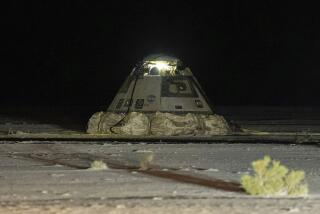‘Everything Is Eerily OK,’ Shuttle Cleared for Flight : Discovery Liftoff Set Thursday
- Share via
CAPE CANAVERAL, Fla. — Discovery’s five astronauts, anxious to break an agonizing 32-month drought in American spaceflight, studied flight plans today as the shuttle was cleared for a Thursday morning launch. NASA officials were nervous but confident.
“Everything is eerily OK,” one official said.
“The space shuttle is ready to fly,” said shuttle administrator Richard Truly, adding, “Even the weather is looking good.”
“This has been a long 2 1/2 years,” Truly said of the difficult period since the Challenger accident in 1986. Liftoff is scheduled for 6:59 a.m. PDT, with a 2 1/2-hour window to take care of weather or technical delays.
After launch officials gave preliminary go-ahead for overnight fueling of Discovery, Truly passed the news to Frederick H. Hauck, the shuttle commander. “The best way to describe him is elated to be headed for space,” Truly told reporters.
Around the Kennedy Space Center area, excitement was mounting. Campers and recreation vehicles found good viewing places across the Indian River. Souvenir sellers set up shop. NASA’s Visitor’s Center sold out of the commemorative envelopes that feature the crew patch.
‘Beginning of the Future’
Deputy NASA Administrator Dale D. Myers exulted that “we have been working 2 1/2 years to put the shuttle back in business, and tomorrow is the day we plan to do that.” He said, “It’s really the beginning of the future for our space program.”
Hauck and his four-man crew had an easy day, relaxing at the crew quarters seven miles from Launch Pad 39B. Their wives were there, too.
The astronauts were to be awakened at 5 a.m. EDT for breakfast, a last-minute weather briefing and time to get into their cumbersome flight suits.
The four-day Discovery mission will be the first shuttle flight since Challenger exploded in a fireball 73 seconds after liftoff from the same launch pad on Jan. 28, 1986, killing all seven aboard, including schoolteacher Christa McAuliffe.
The accident ceded manned space to the Soviet Union, which has put 16 cosmonauts into orbit since then, aboard six flights.
As a result of investigations since the accident, the shuttle fleet and NASA’s management have undergone major changes. The shuttle itself has had 210 modifications, including the addition of an escape system that would enable the crew to bail out if the ship had to ditch in the ocean. The escape system would not have saved the Challenger crew.
$800-Million Redesign
The shuttle booster rockets, blamed for the Challenger tragedy, have undergone an $800-million redesign.
Because of the many changes, Hauck said the mission is considered a test flight. “We’ll probably see some surprises, but I don’t think they’ll be life-threatening surprises,” he said.
Many astronauts and NASA officials have been immensely frustrated with the time it took to fly the shuttle again. When three Apollo astronauts were killed in a launch pad test in 1967, NASA was flying again within 21 months and on the moon nine months after that.
Mission specialist John M. Lounge, one of the Discovery astronauts, said: “The worst thing you can do to an airplane is put it in a hangar for three years and make a lot of changes. When you bring that airplane back, the first thing you do is a test flight to wring out every system and find the surprises. I expect we’ll see some. But I’m satisfied all the changes are necessary and that we’ll have a safer vehicle.”
Lounge and Hauck’s colleagues on the flight are pilot Richard O. Covey, and mission specialists Dale C. Hilmers and George D. Nelson.
More to Read
Sign up for Essential California
The most important California stories and recommendations in your inbox every morning.
You may occasionally receive promotional content from the Los Angeles Times.










